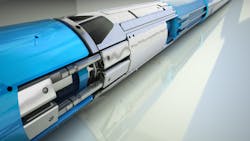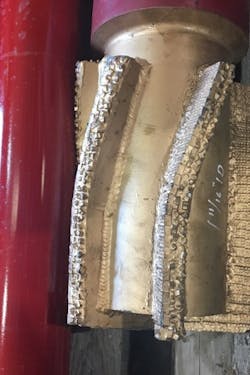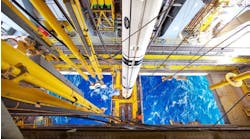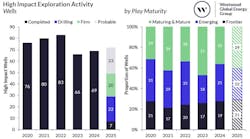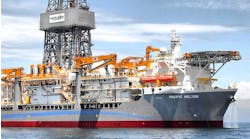Drilling technologies advance to meet challenging reservoir environments
Drilling activities are picking up in a number of offshore regions, and drilling contractors and downhole service firms are developing and introducing new technologies to help operators advance their E&P campaigns.
The North Sea is perhaps the busiest offshore E&P region these days. Here, Baker Hughes, a GE company (BHGE), says that it has successfully deployed its SureCONNECT intelligent downhole system for an operator in the North Sea. The system allows connection of the upper completion components to the lower completion with hydraulic, electric, or fiber-optic conduits.
For the first time, the company claims, operators can attain real-time fiber-optic monitoring across the entire wellbore over the life of the well. This should assist optimization of reservoir performance and help mitigate risks such as equipment failures.
Recently the company introduced its GeoFORM conformable sand management system, which expands and conforms to complex well profiles. This is said to improve sand control performance, with fewer operational requirements.
Under an integrated well services contract for Equinor, BHGE fully integrated eight drilling units during the first half of 2019, in addition to the two existing units.
It employed a remote operations model for part of the project, using automation to improve efficiency and safety and to standardize processes.
Elsewhere in the North Sea, Churchill Drilling Tools says that its DAV MX CircSub has improved a North Sea operator’s wellhead base jetting operations. Having completed a drilling program, the client had to remove cuttings debris from its wellhead base prior to wellhead installation.
However, local sea currents were not sufficient to wash away the cuttings naturally, and the operator wanted to avoid the cost of a dedicated jetting assembly run.
The company decided to run the DAV MX CircSub in the drillstring. After remaining dormant through the drilling phase, the device was activated using a Churchill smart dart to achieve a jetting bypass of 1,200 gallons/min.
The high velocity of the fluid jetting through the device’s four custom angled ports was strong enough to remove the cuttings via two 30-minute sweeps of the wellhead base, allowing the wellhead to be installed soon afterwards.
Elsewhere in the UK offshore sector, the tool was deployed in July to improve hole cleaning, displacements, curing losses and abandonments for various operators.
In the Pacific, Trendsetter Vulcan Offshore (TVO) says it will deploy its new wellhead fatigue mitigation system for Tamarind Resources in the Taranki basin offshore New Zealand.
This is said to alleviate the impact of modern, large BOPs on legacy wellheads by arresting the motion of the BOP stack through four tethers, all anchored to the seafloor.
TVO CEO Jim Maher said that “this lighter and less expensive tethered BOP enables reliable operations on new exploration wells and simplifies re-entry and P&A on older wells.”
The system is said to substantially reduce wellhead cyclic stresses and enhance fatigue life. Depending on the riser and wellhead configuration, fatigue life can be improved by 1,000 times the original unmitigated wellhead fatigue, the company claimed.
Another stated benefit is the increased limit to the rig watch circle, particularly in shallow water, where watch circles can be restrictive.
For the New Zealand program, the technology will be combined with a wireless monitoring system based on Sonardyne’s Subsea Monitoring, Analysis and Reporting Technology (SMART) to reduce wellhead fatigue during the semisubmersible COSLProspector’s upcoming drilling on the Tui oil field.
SMART is said to ensure that operations remain within fatigue safety limits by monitoring movement of the BOP and the bottom of the drilling riser, and providing in situ data processing to extract information such as minimum, maximum and standard deviations for accelerations and rotations in all axes.
According to Kevin Chell of TVO, the new design addresses the need to access wells where the wellhead was not designed to handle the loads and strain induced by modern, larger, and heavier BOPs. “Using our tethering and monitoring system, operators are able to use their subsea infrastructure with confidence for longer, which means they can economically access more resources and extend the life of their fields,” Chell said.
Other new technologies
Diamond Offshore Drilling Inc. has launched its Stack-View service, a solution that applies 24/7 real-time monitoring, data visualization, and analytics to identify trends and detect anomalies in BOP performance across its rig fleet.
The leading indicators derived from the service are said to enable predictive maintenance and subsea downtime prevention, increasing drilling productivity and lowering the total cost of the well.
The real-time data gathered and analyzed by the underlying technology in Stack-View is continuously overlaid or “stacked” with historical data, then data visualization, trending, and advanced analytics is applied to predict when BOP components will fail or when maintenance is required, the company said.
This shift to predictive maintenance from time-based maintenance mitigates stack pulls and maintenance-induced issues, with the ability to reduce non-productive time by up to 50% depending on the water depth and well complexity.
Developed in partnership with Deepwater Subsea LLC, the customized Stack-View platform and dashboards are expected to accessible from any mobile device or computer and any location by early 2020.
Marc Edwards, president and CEO of Diamond Offshore, said: “Subsea equipment repairs and maintenance continues to be a major contributor to a rig’s non-productive time, resulting in great expense to both drillers and operators. We continue to look for ways to improve operational efficiencies and reduce operators’ total cost of ownership to make the economics of offshore drilling more competitive.” With the Stack-View service, Edwards noted, “we will be able to monitor and analyze the health of each BOP across our fleet in real time to make more data-driven decisions that create further cost-savings and performance improvement.”
The company said the new platform is fully configurable and has the future capability to integrate with its Sim-Stack service and BOP failure reporting database. Combined, these systems will provide a holistic view of a BOP’s health as well as past and future performance, allowing the company to transition to conditioned-based maintenance to further reduce costs while increasing subsea equipment reliability.
In addition, the company said the combined solutions will support operators in meeting BSEE’s requirements for 21-day BOP pressure testing frequency.
Weatherford International plc has released the AlphaST single-trip open hole cementing side track system. The company said this is the market’s first system with the capability to initiate side track operations without the need of a cement plug. It is designed to increase operator flexibility, eliminate multiple trips, and avoid costly cementing operations. Dean Bell, president, Well Construction for Weatherford, said: “For operators, AlphaST means you will never again need to side track from a cement plug. AlphaST enables operators to avoid the cost and time of setting a cement plug, waiting on cement and time drilling. The bottomline is opex savings equal to days of rig time.” The company said the system saved an operator 29 hours of rig time and more than $100,000 of operational expense on one well. •

